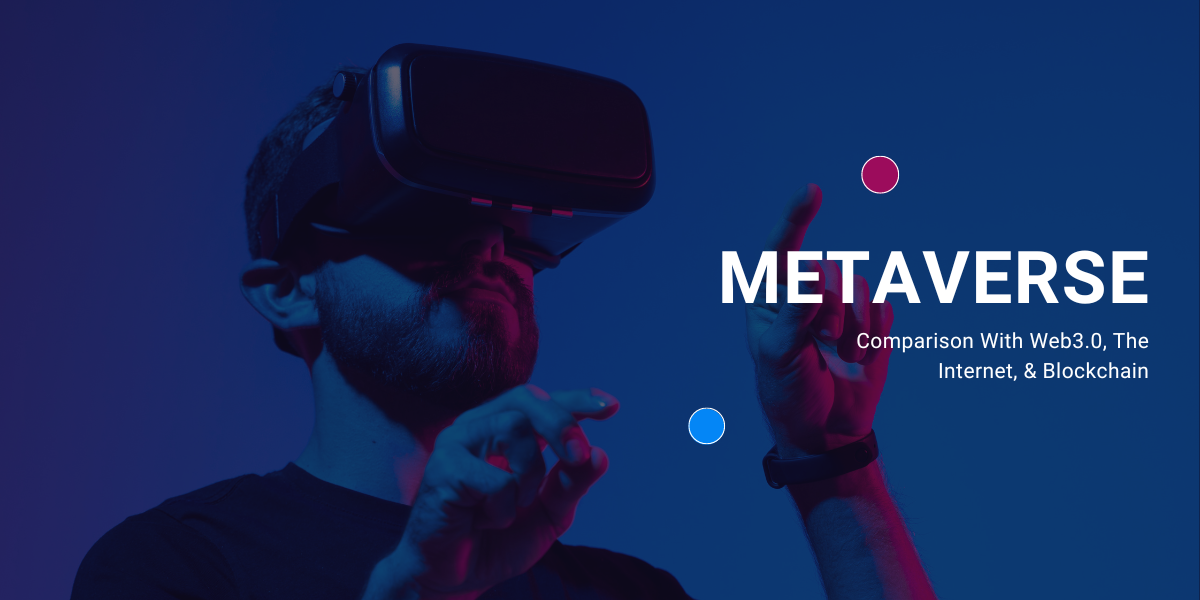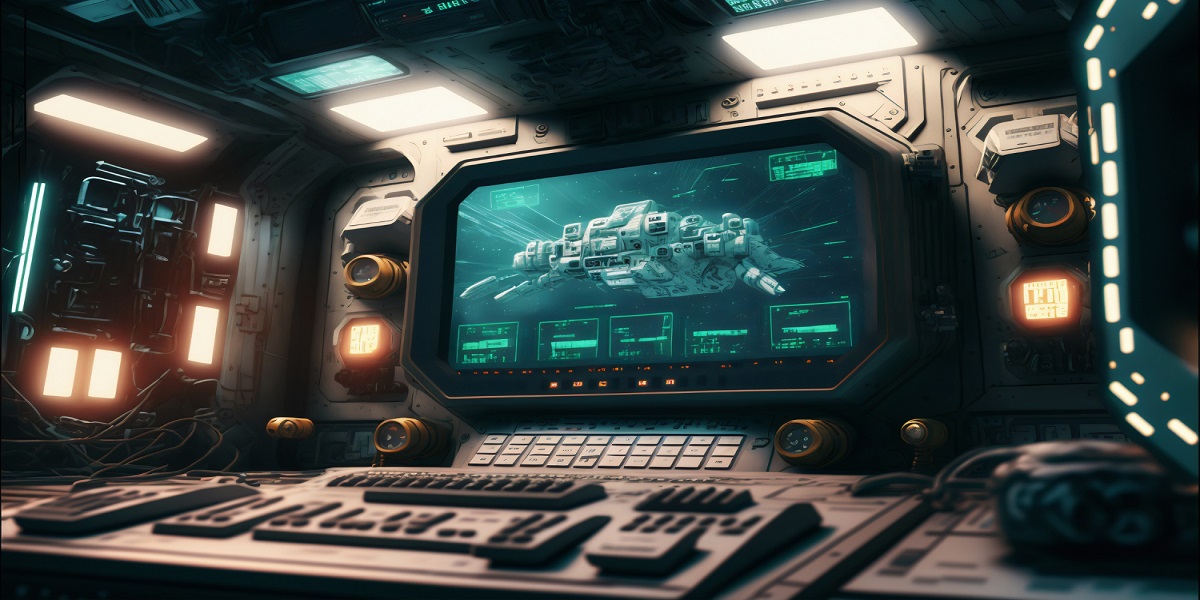
What Is The Metaverse? Comparison With Web3.0, The Internet, & Blockchain
- By Shikha Sharma
- 28-08-2023
- Technology
The digital realm has come a long way since its inception, from basic websites to intricate virtual experiences.
The Metaverse represents the next stage in this evolution, promising an immersive, interconnected digital universe that offers new opportunities and challenges.
What Is Metaverse, Really?
In layman terms, Metaverse is pronounced as a collective virtual shared space environment that includes next-gen technologies such as augmented reality (AR), virtual reality (VR), and the internet.
Furthermore, it’s a space where users interact with each other using tech-savvy gadgets and digital elements.
The following are the key components of the Metaverse:
- Digital Avatars: Users create digital representations of themselves, allowing them to navigate and interact within the Metaverse.
- Virtual Worlds: These are diverse digital environments where users can engage in various activities, from working and socializing to gaming and attending events.
- Blockchain Technology: Decentralized ledgers enable ownership of digital assets, fostering a virtual economy.
- Interconnectivity: The Metaverse uses several connectivity, enabling to link different virtual worlds and movement between them.
- Real-time Interaction: Another key component of Metaverse is that users can communicate with each other in real time, providing them real-life experience.
The History of the Metaverse
The talk about Metaverse is not new, instead evolved over several decades. The history of it blends with science fiction, technological advancement, and cultural imagination.
1960s - 1980s: The Emergence of Virtual Reality
The genesis of the metaverse clue was first laid in the 1960s together with the design concept of virtual reality created on the computer.
1990s: The Birth of the Term "Metaverse"
Neal Stephenson's novel "Snow Crash" introduced the term "metaverse" to describe a digital realm where users interacted as avatars in a shared, three-dimensional space.
The metaverse in the book was a mix of virtual reality, social interaction, commerce, and entertainment.
The early 2000s: Virtual Worlds and Online Games
The early 2000s saw the rise of online virtual worlds and MMORPGs (Massively Multiplayer Online Role-Playing Games). Second Life, launched in 2003, allowed users to create and interact in a shared virtual space.
Additionally, games like World of Warcraft demonstrated the potential of persistent virtual worlds with millions of interconnected players.
Mid to Late 2000s: Social Media and User-Generated Content
Social media platforms like Facebook and YouTube gained prominence, enabling users to connect, share content, and communicate globally.
This era highlighted the growing desire for digital self-expression and virtual interactions.
2010s: VR Resurgence and Blockchain Innovations
The 2010s saw a resurgence of interest in virtual reality with the development of more advanced VR headsets.
Oculus Rift's Kickstarter campaign in 2012 and its subsequent acquisition by Facebook in 2014 catalyzed virtual reality development.
Additionally, the emergence of blockchain technology paved the way for the integration of digital assets and decentralized platforms.
Concepts like NFTs (Non-Fungible Tokens) gained traction, allowing ownership of unique digital items and enabling creators to monetize their virtual creations.
2020s: Convergence of Technologies
As of my last knowledge update in September 2021, the 2020s marked a period of accelerating technological convergence toward a more realized metaverse.
Companies like Facebook (now Meta) have expressed a vision of building a shared, interconnected virtual environment that encompasses social interaction, commerce, entertainment, and work.
Advancements in AI, VR, AR (Augmented Reality), and mixed reality technologies have fueled the expansion of the metaverse concept.
Various industries, including gaming, entertainment, education, and business, are exploring metaverse applications.
Future: Evolution and Challenges
The future of the metaverse remains uncertain but promising.
Challenges such as data privacy, security, digital ownership rights, and equitable access need to be addressed as the metaverse develops.
Its evolution will likely depend on the collaboration of various stakeholders, including technology companies, governments, and users.
In conclusion, the metaverse's history is a tale of technological innovation, speculative fiction, and societal transformation.
Its journey from the pages of a science fiction novel to a complex convergence of digital technologies showcases the remarkable power of human imagination and ingenuity.
Metaverse Examples (The Most Popular Ones)
There are several metaverse examples that have come up in recent years across the globe. Underneath are the same with a brief explanation.
- Second Life: This game is thrilling and entertaining, Second Life allows users to create avatars, build environments, socialize, and even conduct business.
- Fortnite: Fortnite is a popular metaverse game that delivers spontaneous metaverse-like experiences. It hosts concerts, events, and creative modes where players can design their own worlds.
- Roblox: The platform lets users create and share games, experiences, and virtual environments. The game collected immense users across the globe, especially younger audiences.
- Decentraland: Built on blockchain technology, Decentraland is a virtual world where users can buy, develop, and monetize land and assets.
- Minecraft: Another popular Metaverse game, Minecraft is played by millions of people and its in-game content makes it fun.
- Facebook Horizon (now Meta Horizon): Created by Meta Platforms (formerly Facebook), Horizon basically allows users to build their own environments, play games, and interact with others as avatars.
- AltspaceVR: Acquired by Microsoft, AltspaceVR is a virtual events platform that hosts a variety of activities, including meetups, workshops, and performances.
- Entropia Universe: This virtual universe combines gaming with a real economy. Players can buy virtual property, trade virtual goods, and even convert in-game currency into real money.
- Somnium Space: An open, persistent, and immersive virtual reality world that supports user-created content and experiences. It's designed to provide a seamless and immersive metaverse experience.
Web3 vs. The Metaverse: Understanding The Distinction
Web3:
Web3 refers to the next evolution of the internet, envisioning a more decentralized and user-centric online ecosystem.
It aims to address the shortcomings of Web2 (the current internet) by emphasizing data ownership, privacy, and interoperability through the use of blockchain and decentralized technologies.
Here are some key points about Web3:
- Decentralization: Web3 seeks to shift control away from centralized entities like tech giants and towards users. In this scenario, blockchain technology outplayed because it enables decentralized applications (dApps) that run on a distributed network of computers.
- Data Ownership and Privacy: In Web3, holders enjoy greater ownership and controllability to their personal data. They can choose how their data is shared and with whom, reducing the data harvesting and surveillance prevalent in Web2.
- Interoperability: Web3 encourages interoperability between different platforms and services. This means that users can seamlessly move their data and assets between different applications without being locked into a single ecosystem.
- Tokenization and Cryptocurrencies: Web3 often involves the use of cryptocurrencies and tokens for various purposes, including governance, rewards, and transactions within decentralized applications.
- Smart Contracts: Smart contracts are self-executing contracts with terms directly written into code. They enable trustless transactions and automation of processes without relying on intermediaries.
The Metaverse:
As said earlier, metaverse is a shared virtual space (environment) designed with technologies including virtual reality.
Ironically, it incubates a large range of digital environments that can be used for interactions, socializing, creating content, and engaging in events.
Here are some key points about the metaverse:
- Virtual Reality and Immersion: The genesis of metavers is represented by its immersive nature, incorporating technologies like virtual reality (VR) and augmented reality (AR). Users can navigate and interact with the virtual environment through avatars.
- Diverse Experiences: The metaverse offers a broad spectrum of experiences beyond the internet's current capabilities. These experiences can include gaming, social interaction, education, entertainment, work, and commerce.
- Virtual Economies and Assets: Many metaverse environments have their own economies, often based on virtual assets and digital ownership, facilitated by technologies like blockchain and NFTs.
- Shared Spaces and Persistent Worlds: The metaverse comprises interconnected virtual spaces that can persist over time. Users can interact with these spaces and their inhabitants, creating a sense of continuity and community.
Metaverse vs. The Internet: Understanding The Differences
Here's a breakdown of the key differences between the two:
1. Nature of Interaction
- Internet: The Internet is a global network of interconnected computers and servers that enables the exchange of information, communication, and access to online resources. It primarily facilitates the sharing of data, websites, and online services.
- Metaverse: The metaverse is a collective virtual space that goes beyond the internet's capabilities. It involves immersive, interactive experiences where users can inhabit digital environments, socialize, create content, and engage in various activities. It blends the virtual and physical worlds to create a more dynamic and interconnected digital universe.
2. User Experience
- Internet: Indeed, the internet incubates immersive content, from static websites to changing applications. Users consume this content through web browsers, search engines, and applications.
- Metaverse: In the metaverse, user experiences are more immersive and interactive. Users can navigate virtual spaces using avatars, interact with objects and other users, and participate in virtual events, games, and activities. The metaverse aims to provide a sense of presence and embodiment in digital environments.
3. Spatial Dimension
- Internet: The internet is primarily a two-dimensional space where content is organized on web pages and accessed through links and URLs. It lacks a strong spatial component.
- Metaverse: The metaverse introduces a three-dimensional spatial dimension. Virtual environments within the metaverse can be explored in a manner similar to physical spaces, offering a sense of depth, scale, and interaction that is not prevalent on the traditional internet.
4. Digital Ownership
- Internet: Digital assets and content on the internet are often owned by centralized platforms and can be easily copied or duplicated. Ownership of digital items can be challenging to establish.
- Metaverse: The metaverse integrates digital ownership more securely through technologies like blockchain and non-fungible tokens (NFTs). Users can have verifiable ownership of unique digital items, which can include virtual real estate, art, collectibles, and more.
Blockchain, Web3, and The Metaverse: Interconnections And Impact
A) Blockchain
Blockchain is a decentralized and immutable digital ledger technology that underpins various aspects of Web3 and the metaverse.
It consists of a chain of blocks, each containing a record of transactions.
These blocks are linked using cryptographic hashes, ensuring security and transparency. Here's how blockchain relates to Web3 and the metaverse:
Data Security and Transparency: Blockchain enhances data security by creating a tamper-resistant record of transactions. This is crucial in the metaverse, where digital ownership of assets and identity verification are key concerns.
Digital Ownership and NFTs: Non-fungible tokens (NFTs), which are unique digital assets representing ownership of items in the metaverse, often utilize blockchain technology. Blockchain ensures the provenance, authenticity, and ownership of these digital items, enabling creators to monetize their work and users to own and trade virtual assets.
Decentralization and Trust: Blockchain's decentralized nature eliminates the need for intermediaries, fostering trust and reducing the risk of censorship. This aligns with Web3's goal of creating a user-centric, decentralized internet.
B) Web3
Web3 refers to the next evolution of the internet, emphasizing user control, data ownership, and decentralized applications (dApps).
It leverages blockchain and other decentralized technologies to create a more user-centric online ecosystem.
Here's how Web3 relates to blockchain and the metaverse:
Decentralized Applications (dApps): Web3 enables the development of dApps that run on decentralized networks, often utilizing blockchain as their backbone. These applications can range from social platforms to financial services and virtual worlds within the metaverse.
User Data Ownership: Web3 puts users in control of their data, allowing them to decide how their personal information is shared and accessed. This aligns with the metaverse's need for secure and private interactions among users and their virtual assets.
Interoperability and Open Standards: Web3 promotes interoperability between different platforms and services. This is crucial in the metaverse, where users may traverse multiple virtual worlds and environments, necessitating seamless data and asset portability.
C) The Metaverse
The metaverse is an interconnected digital universe comprising virtual spaces, experiences, and interactions.
It leverages technologies like blockchain and Web3 to create immersive, shared environments.
Here's how the metaverse relates to blockchain and Web3:
Digital Ownership and NFTs: The metaverse relies on NFTs and blockchain to establish digital ownership of virtual assets, ranging from virtual real estate and art to in-game items and experiences.
Virtual Economies: Blockchain-enabled virtual economies in the metaverse allow users to buy, sell, and trade digital goods using cryptocurrencies or tokens, aligning with Web3's vision of decentralized commerce.
Decentralized Governance: Some metaverse projects use blockchain's decentralized governance models, where decisions about the development and evolution of virtual spaces are made through community consensus.
In conclusion
Blockchain, Web3, and the metaverse are interconnected components shaping the future of digital experiences.
Blockchain provides security, ownership, and trust; Web3 fosters user control and decentralized applications; and the metaverse creates immersive virtual spaces for social interaction, commerce, and creativity.
Together, these technologies lay the foundation for a more inclusive, interactive, and decentralized digital landscape.
Recent blog
.jpg)
Can artificial intelligence help farmers to feed 10 Billion people?
Artificial Intelligence | 06-05-2024
How NASA Uses Web Design to Optimize User Experience in Space Control
Web Design | 03-05-2024




